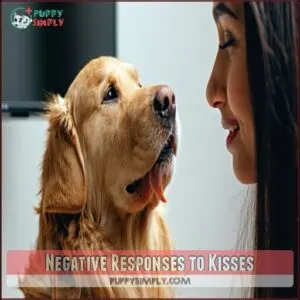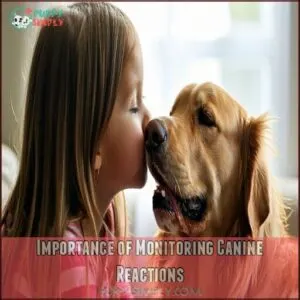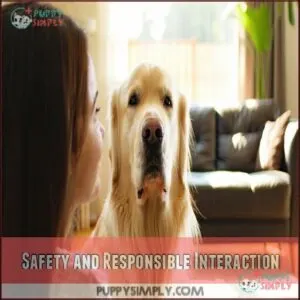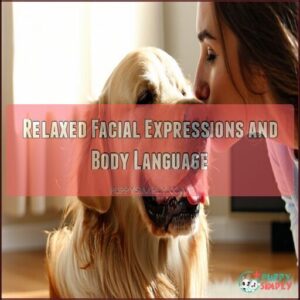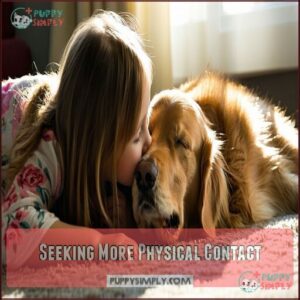This site is supported by our readers. We may earn a commission, at no cost to you, if you purchase through links.
 You’re wondering if dogs like kisses – it’s a common question.
You’re wondering if dogs like kisses – it’s a common question.
Most dogs associate kisses with love and attention, and they often show signs of enjoyment, like wagging their tails or licking you back.
However, this is vital to pay attention to your dog’s body language, as some may not appreciate kisses.
You’ll learn more about canine communication and how to tell if your dog enjoys kisses, including signs of stress and discomfort, and what it means when they lick you, as you explore the sphere of dog affection and interaction.
Table Of Contents
- Key Takeaways
- Canine Communication Styles
- Do Dogs Like Kisses
- Canine Reactions to Kisses
- The Meaning of Dog Licks
- Safety and Responsible Interaction
- Interpreting Canine Affection and Physical Reactions
- Signs a Dog Enjoys Kisses
- Alternatives to Kissing for Showing Affection
- Health Considerations of Kissing Dogs
- Cultural Perspectives on Kissing Dogs
- Frequently Asked Questions (FAQs)
- Do dogs like kisses?
- How to understand why dogs don’t like being kissed?
- What does a dog kiss mean?
- Is licking a dog a ‘Kisse’?
- Do dogs understand when you kiss them?
- How do I tell my dog I love him?
- Do dog licks actually mean kisses?
- Do dogs like being hugged and kissed?
- Do dogs feel love when we kiss them?
- Do dogs feel love when you kiss them?
- Conclusion
Key Takeaways
- You’ll know your dog enjoys kisses when they display relaxed body language, such as a loose posture, soft eyes, and a wagging tail, and they seek more affection after receiving kisses.
- It’s crucial to pay attention to your dog’s body language and behavior to understand their unique comfort level with kisses, and adjust your interactions accordingly to avoid signs of stress and discomfort.
- You can show your dog love and affection in many ways beyond kissing, such as gentle petting, playtime, and positive reinforcement, which can help build a strong bond with your dog without making them uncomfortable.
- By understanding your dog’s individual preferences and boundaries, you can create a deeper connection with them, and it’s essential to respect their boundaries and prioritize their comfort when showing affection, whether it’s through kisses or other forms of physical contact.
Canine Communication Styles
As you explore canine communication, you’ll discover that dogs rely heavily on body language and facial expressions to convey their thoughts and feelings.
By understanding these non-verbal cues, you can better navigate your interactions with dogs and determine whether they truly enjoy kisses or not, which is crucial for a harmonious relationship, emphasizing the importance of canine communication.
Differences in Human and Dog Communication
You’ve probably noticed your dog tilting their head, trying to decode your words.
Canine communication differs from human verbal cues, relying on body language and vocalizations. To understand your dog’s "words," pay attention to their movements and signals.
Some key signals include:
- Tail wagging, which can indicate excitement or stress
- Yawning or lip licking, revealing discomfort or calmness
- Avoiding head-on approaches, as they can be perceived as threats.
By recognizing these cross-species signals, you can improve your communication with your dog, avoiding human misinterpretations of canine body language and fostering a deeper understanding of dog behavior and emotions.
Understanding dog body language is key to effective interaction.
Importance of Body Language in Dogs
You can better understand your dog’s feelings by learning dog body language.
Reading Tail Wags and Understanding Facial Expressions help decode canine behavior.
| Signal | Meaning | Example |
|---|---|---|
| Wagging Tail | Excitement | Happy dog |
| Tucked Tail | Fear | Scared dog |
| Relaxed Ears | Calmness | Content dog |
| Pinned-Back Ears | Stress | Anxious dog |
Learning to Associate Human Actions With Meaning
You can teach your dog that kisses mean affection by creating learned associations.
Context matters, and interpreting dog behavior helps strengthen this bond.
Here’s how:
- Reward calm reactions with treats
- Use a happy voice and gentle touch
- Watch for cues like wagging tails
- Respect individual preferences
- Pair kisses with petting or fun activities
With positive reinforcement, you’ll shape your dog’s behavior and strengthen your bond.
Dog kisses and affection will grow naturally as you follow these steps, considering individual preferences and early experiences in dog communication and human affection, leading to a stronger bond and more affection.
Do Dogs Like Kisses
You’re wondering if dogs like kisses. They don’t naturally understand kisses as love, but learn over time.
- Breed differences impact their openness to dog kisses.
- Owner influence helps dogs associate kisses with positive emotions.
- Canine affection thrives on comfort and trust.
- Individual preferences vary, making it important to respect boundaries and prioritize comfort when showing affection through kisses.
Some breeds, like German Shepherds, may show affection through snuggling for security, which is a key aspect of canine affection and helps in building trust.
Canine Reactions to Kisses
As you interact with your dog, it’s vital to pay attention to their reactions to kisses, as they can range from signs of stress and discomfort to positive responses.
You’ll need to monitor your dog’s body language and behavior to understand their unique comfort level with kisses, and adjust your interactions accordingly, which can help you identify positive responses.
Signs of Stress and Discomfort
When kissing your dog, watch for signs of stress like a stiff body, lip licking, or yawning signals.
These appeasement signals indicate discomfort.
Turning away or growling signs also show dog stress and anxiety.
Recognize these calming signals to avoid escalating dog stress, ensuring a comfortable interaction for both you and your pet, and understand the importance of calming signals.
Positive Responses to Kisses
You’ll know your dog enjoys kisses when you see a relaxed face, medium-height tail wags, and soft eyes.
Signs of affection include:
- Seeking contact
- Returning licks
- Active participation.
Your dog may lean into you, showing dog love and affection, strengthening your bond through dog bonding and affection.
Negative Responses to Kisses
You notice stress signals like pinned-back ears or stiff posture.
Avoidance behaviors include yawning or pulling away.
| Signal | What It Means |
|---|---|
| Yawning | Anxiety |
| Lip-licking | Stress |
| Pulling away | Discomfort |
| Growling | Bite risk |
| Avoiding eye contact | Confusion displayed |
Watch for these stress signals to avoid aversion behaviors and guarantee a safe interaction, understanding dog behavior and stress signals.
Importance of Monitoring Canine Reactions
You can strengthen your bond with your dog by monitoring their reactions.
Watch for subtle cues like
- Lip-licking
- Yawning
- Head turning
- Body stiffening, which are stress signals.
Consistent observation helps you understand individual differences in dog behavior and comfort levels, allowing you to respond to their unique needs, which can help you strengthen your bond.
The Meaning of Dog Licks
As you explore the sphere of canine communication, you’ll find that dog licks can have multiple meanings, including affection, submission, and exploration.
By understanding what your dog’s licks mean, you can better navigate your interactions and build a stronger relationship with your pet.
Instinctive Communication and Affection
You’re tapping into your dog’s primal canine instincts when they lick you, displaying affection rooted in maternal care.
This behavior showcases bonding signals, stemming from a pack mentality where dogs use licking as a form of communication and affection display, revealing their emotions and dog behavior, and strengthening human affection through canine instincts.
Submission Signals and Attention-Seeking
You see your dog’s licking as a sign of affection, but it can also be an appeasement behavior, signaling respect.
- Licking triggers attention from you, reinforcing learned submissiveness in dog behavior and psychology, showcasing dog emotions through submission signals and attention-seeking tactics.
Exploration and Information Gathering
You’ll find that dogs use licking as a way to gather information, exploring their environment through scent.
| What They Learn | How They Learn It |
|---|---|
| Emotional State | Licking after kisses |
| Physical Condition | Sensory input from licks |
| Environmental Awareness | Scent exploration |
This canine curiosity varies by breed, with some dogs being more prone to dog licking as a means of sensory input, showcasing dog affection and dog behavior rooted in dog language and dog emotions.
Self-Soothing Mechanisms for Anxiety or Injury
You notice your dog’s licking habit serves as a built-in calming mechanism, releasing endorphins to ease anxiety or injury, like licking wounds.
Excessive licking may signal deeper stress, so provide comfort objects to manage dog anxiety and stress signals, utilizing dog calming techniques to relieve dog stress.
Safety and Responsible Interaction
As you interact with dogs, to prioritize safety and responsible interaction is vital to avoid misunderstandings.
You should be aware of risk factors for dog bites, warning signs of aggression, and safe practices for interacting with dogs to make certain a positive experience for both you and the dog.
Risk Factors for Dog Bites
When interacting with dogs, you’ll want to think about risk factors for dog bites.
Here are some key points:
- Be cautious with child interaction, as kids often miss warning signs.
- Unfamiliar dogs can pose a threat, so approach with care.
- Watch for warning signs like stiff bodies or lip licking.
- Preventative measures, such as supervising interactions, can reduce bite severity.
Remember, dog safety is key, especially around children, to avoid dog biting and make a safe environment.
Statistically, unneutered male dogs are more likely to bite.
Warning Signs of Aggression
You’re getting close to your dog, but beware of warning signs. A stiff body, lip lifting, or "whale eye" can signal discomfort.
Watch for:
- Raised fur
- Pinned ears
- Avoiding eye contact
- Growling signs
These indicate your dog feels threatened, and you’re at risk of dog biting or snapping behavior, a clear dog threat. Understanding dog bite prevention methods is essential for safety.
Recognize these dog danger signs to prevent dog defensive behavior.
Safe Practices for Interacting With Dogs
A dog’s personal space deserves the same respect as your own when creating safe interactions. Approaching from the side rather than face-to-face reduces threat perception, while paying attention to their signals—like yawning, lip licking, or stiffening—helps prevent uncomfortable situations.
Always supervise children around dogs and teach them to respect boundaries. Consider various options for effective bite prevention when interacting with dogs.
- Use a gentle approach, moving slowly with a relaxed posture when greeting unfamiliar dogs
- Create designated "retreat zones" where your dog can escape when feeling overwhelmed
- Learn to recognize subtle warning signals that indicate your dog needs space
If your dog engages in face licking, don’t assume it’s always affection—it may indicate stress or submission. Most dog bites happen when humans miss these vital communication cues. Remember, even the friendliest pups need their space sometimes!
Educating Children on Canine Safety
Teaching children to grow up with dogs starts with understanding canine safety fundamentals. Show kids how to practice safe touching by demonstrating gentle petting on a dog’s back rather than risky face kisses.
Help them decode reading signals—when a dog turns away, yawns, or pins their ears back, they’re setting boundaries that deserve respect. Always supervise interactions between children and dogs, especially since kids under 12 account for a significant portion of dog bite incidents.
Create a simple rule: "If you wouldn’t like someone doing it to you, don’t do it to the dog." Explain that while dog licking might seem like kisses, face licking can sometimes indicate stress rather than affection.
Use role-playing games for bite prevention education: "Show me what you’d do if Rover looks scared." To further guarantee their well-being, consider investing in specialized products for kids.
Safety creates confidence, not fear.
Interpreting Canine Affection and Physical Reactions
You’ll notice your dog communicates affection through subtle physical cues like relaxed posture, gentle tail wags, and seeking more contact when they enjoy your kisses.
Learning to read these signals helps you understand when your pup welcomes your smooch and when they’d prefer another form of attention, like their favorite belly rub.
This approach allows you to better recognize your dog’s preferences, making interactions more enjoyable for both you and your pet, especially when you use gentle gestures.
Tail Wags and Approaching for More Affection
Your dog’s tail speaks volumes about their feelings toward your affection. A relaxed, side-to-side wag paired with soft eyes indicates genuine enjoyment when you show love through kisses.
When interpreting dog affection signals, watch for these key behaviors:
- Seeking proximity immediately after receiving kisses
- Reciprocal licking combined with gentle nudging against your face
- Play bows or wiggling behinds when approaching for more attention
Not all tail movement conveys the same message—some dogs adore your kisses while others merely tolerate this species-specific behavior. Pay attention to their complete body language; if they lean in for more after a kiss, they’re clearly communicating their desire for continued affection.
Associations With Positive Reinforcement
Through consistent positive reinforcement, your dog can form strong associations with kisses over time.
This trained affection happens when you pair smooch sessions with rewards your dog already values.
Creating positive associations is straightforward:
- Treat Timing – Offer a small treat immediately after each kiss to build a reward connection
- Verbal Celebrations – Use enthusiastic praise in a high-pitched voice that dogs naturally respond to
- Play Rewards – Follow affection with a quick game that engages your pup’s natural instincts
- Consistent Signals – Use the same approach each time so your dog understands what’s coming
Dog licking often follows when this learned behavior takes hold.
Context and Perception of Kisses
How does your dog actually perceive those affectionate smooches you love to give?
Your dog doesn’t naturally understand kisses as signs of affection, but can learn to associate them with positive experiences through consistent interaction. Context matters substantially in shaping their perception.
| Kissing Context | Dog’s Likely Perception |
|---|---|
| With treats | Positive reinforcement |
| During play | Part of fun interaction |
| When stressed | Potential threat |
| With high voice | Excitement signal |
| After absence | Reunion ritual |
Individual preferences vary widely based on temperament and past experiences. Some dogs readily accept human affection through kisses, while others may interpret close facial contact as threatening. Watch for subtle communication cues that reveal your dog’s emotional understanding of these interactions.
Belly Rubs and Preferred Physical Contact
While kisses might confuse some canines, most dogs appreciate physical touch that respects their individual comfort zones.
Understanding your dog’s contact preferences creates stronger bonds than human-style affection.
Here’s how to discover your pup’s favorite physical connection methods:
- Observe body language – Relaxed muscles and soft eyes indicate enjoyment during belly rubs or other touching
- Identify sweet spots – Some dogs melt for belly rub benefits while others prefer ear scratches or doggy massage along their spine
- Notice pressure preferences – Gentle strokes work for sensitive dogs while others enjoy firmer contact
- Watch for invitation signals – Dogs who roll over or nudge your hand are requesting more affection
Safe touching means reading your dog’s signals and adjusting your petting style accordingly.
Signs a Dog Enjoys Kisses
You’ll know your dog actually enjoys your smooches when they display relaxed body language and enthusiastically seek more affection after receiving kisses.
Watch for a loose, wiggly posture, soft eyes, gentle tail wags, and how they might even return the gesture with gentle licks of their own, which can indicate they are seeking more affection and possibly even trying to return the gesture.
Relaxed Facial Expressions and Body Language
You’ll know your dog enjoys kisses when they display relaxed ears, soft eyes, and an open mouth.
A loose tail and calm posture also indicate comfort. Watch for fluid movements, not stiffness, to confirm they’re at ease.
Recognizing these dog body language cues helps you decode their emotions and build trust through better awareness of dog communication signals and appeasement gestures.
Returning Affection Through Licking
You notice your dog licks you after a kiss, which might be their way of showing affection.
Licking can strengthen trust and mimic pack bonding.
Signs include:
- Wagging tail
- Relaxed ears
- Gentle eye contact
- Playful licking
- Happy posture, indicating they feel safe and comfortable with you, releasing endorphins through this learned behavior.
Seeking More Physical Contact
You’ll see your dog seeking more physical contact after kisses, a clear sign they enjoy your affection.
They’ll show affection cues like:
- Leaning against you
- Placing their paw on you
- Nudging your hand
- Following you around.
These behaviors indicate their love language includes physical touch, asking for more affection and bonding activities, revealing their touch preferences and comfort levels with kisses and human affection.
Active Participation in Interactions
As you engage with your dog, they’ll show reciprocal affection through active participation.
You’ll observe:
- Playful body language
- Interactive responses
- Training integration
- Shared activities, indicating they enjoy your dog kisses.
This playful engagement showcases respectful interactions, highlighting the importance of boundary setting and communication in your behavior, including licking, to foster a strong bond.
Alternatives to Kissing for Showing Affection
You can show your dog love and affection in many ways beyond kissing, and finding what works best for your pet is key.
By trying alternatives like gentle petting, playtime, and positive reinforcement, you can build a strong bond with your dog without making them uncomfortable.
Gentle Petting and Scratching Favorite Spots
You’ll find your dog’s sweet spot with gentle petting and scratching techniques, often preferred over kisses.
Discover your dog’s sweet spot with gentle petting and scratching techniques, a great alternative to kisses.
Try ear rubs, belly rubs, and chin scratches, observing their reaction to determine their favorite spots.
Considering location sensitivity and pressure preferences can strengthen your bond and promote dog emotional wellbeing through affection.
Quality Playtime and Interactive Games
You can strengthen your bond with your dog through quality playtime and interactive games.
Try these activities:
- Fetch Variations
- Puzzle Toys
- Agility Courses.
These dog enjoyable activities, including dog play and dog training, reinforce your dog bond.
Many owners find that snuffle mats aid stimulation, offering a great way to engage a dog’s mind.
With sensory play and training games, you’ll create a fun experience, making dog toys and interactive games a great alternative to kissing, promoting a healthy dog bond reinforcement.
Positive Reinforcement With Treats and Praise
You can effectively show affection to your dog through positive reinforcement with treats and praise.
Often, treats are a great way to speak their language. Use small, irresistible treats paired with upbeat verbal praise to celebrate wins.
- Clicker training helps with treat timing
- Consistency is key to shaping behavior.
Reward consistency keeps dog training exciting, showing affection in a way they understand, leveraging positive reinforcement to boost motivation levels and dog behavior, making dog commands and dog rewards more effective in dog training.
Providing Mental Stimulation and Enrichment
You can provide mental stimulation with puzzle toys and training games.
This challenges your dog’s intelligence and curiosity.
- Rotate novelty items
- Try scent work
- Use interactive feeders
Practice socialization skills, enhancing dog behavior through dog training sessions and dog intelligence games, making dog entertaining activities and dog learning fun.
Health Considerations of Kissing Dogs
You should consider the health implications of kissing your dog, as it can transfer bacteria and germs.
When you kiss your dog, you’re at risk of contracting zoonotic diseases or experiencing allergic reactions to their saliva, so practicing good hygiene is vital.
Bacterial Transfer and Hygiene Practices
When kissing your dog, consider the germ transmission risks. Dog saliva contains hundreds of bacterial species, but a healthy immune system minimizes infection risks.
To mitigate mouth contact risks, wash your hands after kissing your dog. Hygiene importance can’t be overstated, as dog germs and mouth bacteria can be transferred.
Saliva risks include antibiotic-resistant germs and Salmonella transfer. Implement preventative measures like regular dental care and hand washing to reduce dog kissing risks.
By taking these steps, you can enjoy kissing your dog while minimizing the risks of germ transmission and bacteria transfer, keeping both you and your dog healthy.
Potential Allergic Reactions to Dog Saliva
When your dog licks you, their saliva can trigger allergic reactions.
You may experience:
- Redness
- Itching
- Hives
- Sneezing
- Swelling
These Saliva Allergen Types can cause cross-reactivity concerns, leading to allergic reaction symptoms.
Managing dog allergies is key, and desensitization therapies can help.
Be aware of dog germs and potential dog allergies when your dog licks you, as their saliva contains proteins that may cause issues.
Zoonotic Diseases and Prevention Measures
You can minimize the risk of zoonotic diseases by taking precautions.
- Schedule veterinary check-ups
- Practice hand washing
- Maintain dog oral health, preventing parasite transmission and keeping you and your dog healthy, ensuring safe affection for years to come, through good hygiene practices and vaccination importance, under the guidance of a veterinarian, for public health and dog health, which is crucial for public health.
Cultural Perspectives on Kissing Dogs
You’re about to explore how different cultures view kissing dogs, and it’s interesting to see how variations in pet affection exist across the globe.
As you read on, you’ll discover historical changes in human-dog relationships, religious and social views on dog interactions, and modern trends in treating dogs as family members.
Variations in Pet Affection Across Cultures
When interacting with dogs across cultures, you’ll find unique affection displays.
In Western cultures, kisses and hugs are common, while in Asia, head pats and quiet time are preferred. European cultures offer a range of affection, from belly rubs to massages.
Understanding these cultural differences in Global Affection Norms and Cultural Pet Boundaries can help you navigate Affectionate Ritual Differences and Breed Affection Variance, ultimately strengthening your human-dog relationship and avoiding misunderstandings in dog behavior and interactions.
Dogs may also express affection through what’re known as dog love bites, a common form of canine communication.
Historical Changes in Human-Dog Relationships
You know, our bond with dogs? It’s gone through some wild changes!
- Domestication Timeline shows dogs started as hunters, not cuddlers.
- Evolving Roles shifted from work to family.
- Breed Development created specialized companions.
- Shifting Perceptions made dogs "fur babies".
- Modern Companionship means gourmet food and doggy spas!
The human-dog relationship shows affection replaced utility. Dogs became more than helpers; they’re family.
This bonding highlights dogs’ emotional ties, making social interaction a mix of loyalty, trust, and shared affection. It’s a tail-wagging good time!
Religious and Social Views on Dog Interactions
You’ll find diverse views on dog interactions across cultures.
Consider these perspectives:
- Buddhism views dogs as spiritual guides
- Islam emphasizes respectful care
- Hinduism reveres dogs as loyal protectors
- Western cultures treat dogs as family members, with affection like kisses, amidst cultural norms and ethical considerations.
Modern Trends in Treating Dogs as Family Members
You’re part of the dog humanization trend, treating your pet like a "fur baby."
This shift in pet parenting styles has led to stronger dog-owner relationships. As a result, canine lifestyle trends now include luxury dog products and experiences.
You show dog affection through physical touch, creating a deep bond. Dog emotional love is unique, and they thrive on interaction.
In the dog-human relationship, you play a significant role in their happiness. By embracing pet affection and understanding dog human interaction, you nurture a lifelong connection with your pet, making them an integral part of your family and daily life, which is a result of the dog humanization trend and canine lifestyle trends.
Frequently Asked Questions (FAQs)
Do dogs like kisses?
In regards to kisses, you’re likely wondering if dogs are on the same page, but truthfully, they don’t naturally interpret kisses as affection, it’s a learned behavior.
How to understand why dogs don’t like being kissed?
You’ll understand why dogs don’t like being kissed by observing their body language, such as turning away or stiffening, indicating discomfort or stress from close face contact.
What does a dog kiss mean?
What does a dog’s sloppy kiss mean to you?
It’s likely a sign of submission, affection, or anxiety, as dogs lick to gather info, show love, or calm themselves.
Don’t you think?
Is licking a dog a ‘Kisse’?
You might think licking is a ‘kiss,’ but it’s actually a complex behavior with various meanings, including submission, exploration, or affection, depending on the context and your dog’s individual personality traits.
This behavior can have different implications based on the situation and the dog’s unique characteristics.
Do dogs understand when you kiss them?
You kiss your dog, but they don’t naturally interpret kisses as affection, often finding close face contact threatening, and may associate kisses with positive feelings over time through paired behaviors.
How do I tell my dog I love him?
Like a warm hug, show your dog love through gentle petting, soothing voice, and quality time, making them feel cherished and valued in your life every day.
Do dog licks actually mean kisses?
You’ll find that licks from your furry friend can signify affection, submission, or even stress, not necessarily kisses, as they associate licking with comfort and communication, not romance.
Do dogs like being hugged and kissed?
You’ll be surprised that 400,000 dog bites occur annually; dogs often don’t enjoy hugs or kisses, finding them threatening or confusing, so approach with caution and respect their boundaries.
Do dogs feel love when we kiss them?
You wonder if dogs feel love when kissed; they may associate kisses with affection over time, but it’s not a natural sign of love for them, requiring patience and understanding.
Do dogs feel love when you kiss them?
You can help your dog associate kisses with love by pairing them with positive interactions, but dogs don’t naturally interpret kisses as affection, and some may feel uncomfortable or anxious.
Conclusion
Deciphering the mystery of canine affection, you’ll find that do dogs like kisses is a complex question.
By paying attention to body language, you’ll discover your dog’s unique preferences, and whether they enjoy kisses or not, allowing you to show love and affection in a way that resonates with them.
Answering the question of do dogs like kisses once and for all.
- https://www.rd.com/article/do-dogs-like-kisses/
- https://ctvsh.com/services/dogs/blog/why-do-dogs-give-kisses.html
- https://www.countryliving.com/uk/wildlife/pets/a36130023/why-do-dogs-lick-you/
- https://www.quora.com/Do-dogs-like-to-be-kissed
- https://www.dailypaws.com/dogs-puppies/dog-behavior/dog-psychology/do-dogs-like-kisses




